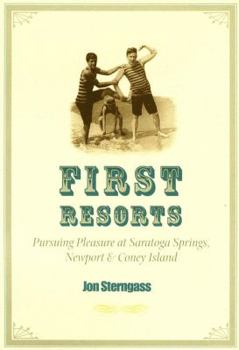First Resorts: Pursuing Pleasure at Saratoga Springs, Newport, & Coney Island
Select Format
Select Condition 
Book Overview
In this work, Jon Sterngass follows three of the best-known north-eastern American resorts across a century of change. Saratoga Springs, Newport and Coney Island began, he finds, as similar pleasure... This description may be from another edition of this product.
Format:Hardcover
Language:English
ISBN:0801865867
ISBN13:9780801865862
Release Date:November 2001
Publisher:Johns Hopkins University Press
Length:384 Pages
Weight:2.25 lbs.
Dimensions:1.2" x 7.3" x 10.4"
Customer Reviews
1 rating
The Invention of American Leisure
Published by Thriftbooks.com User , 22 years ago
Sterngass's history of three of the first American resorts -- Saratoga Springs, Newport, and Coney Island -- shows in fascinating detail how these sites came to give birth to commercial leisure in the U.S. Destined for classic status, Sterngass has a solid theoretical grasp of the changing socioeconomics of leisure, and a winning narrative style. Built on exceptionally deep research, he weaves a dense and satisfying narrative of each resort and its place in American society from the early antebellum era to the early 20th century. Using primary sources such as diaries and letters as well contemporary newspapers and magazines, he shows with masterful command how each resort was shaped and then undone by local, regional, and national sociopolitical and economic factors. He shows through lively anecdote, public records, brief biographies, and other primary sources, how these resorts at first document the free sociality of the antebellum period, a period during which Americans self-consciously created the institutions and practices of the first democratic society. He then shows how after the Civil War the concomitant rise of class distinctions based on wealth, the commercialization of leisure culture and its increasing privatization meshed with new consumerist values in such a way as to scuttle these egalitarian and democratic ideals as expressed through the relatively open culture of early resorts.Sterngass relates, for instance, how it was that during an age of extreme religious piety (the Second Great Awakening) resorts were able to prosper in a still largely Calvinist society. He argues persuasively that early resort goers were part of long tradition of pilgrimage that had blossomed back in the Middle Ages.Saratoga's early entreprenuers touted the "healing" waters as"therapeutic," the "bathing" at Newport and Coney Island was touted by doctors as "restorative" and "re-creative." Not unlike the opium-laced patent medicines of the time, the healing waters were a cover for loosening of the usual social restraints. When tourists got to these early resorts, the hotel ballrooms (which featured nightly dancing), dining rooms (where twenty guests unknown to each other would be seated at table -- a practice which scandalized the European aristocracy who visited), and vast lobbies and porches (which fostered mingling, talking, and voyeurism) served as liminal spaces where the unexpectedly erotic or socially fortuitous meeting might occur. By contrast, the guest's rooms were tiny and ill-ventilated, a fact that seemed to bother no one -- after all the point was to see and be seen. And, just as importantly, there was no set formula, no expectation as to what accommodations in a resort hotel should be like. He also notes that for a country believed to be resolutely puritanical in its beliefs and industrious in its practices, that almost all Americans of the antebellum period went on vacation, and that a vacations of a month or more were common a




